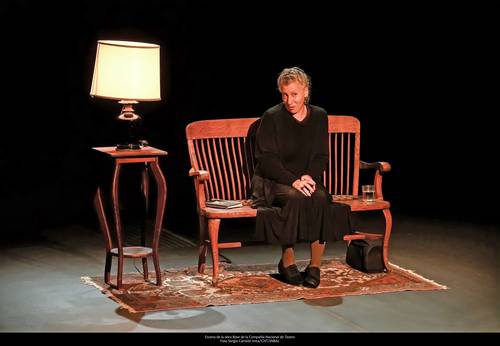Theater in Mexico experienced a true revival in 2024, which not only reaffirmed the return to in-person activities after confinement, but also consolidated the crucial role of the performing arts as an engine of reflection, criticism and social transformation.
This year witnessed a combination of proposals that enriched the national and global scene, combining the traditional with the contemporary in a dynamic of constant innovation.
The country’s venues, driven by the post-pandemic cultural effervescence, became meeting points for thousands of spectators. The return to in-person theater evidenced the resilience of the performing arts, which, far from remaining anchored in the past, opened new paths towards the future.
On a national scale, the National Theater Company (CNT) paid tribute to Sor Juana Inés de la Cruz with The efforts of a house, baroque comedy that unraveled the complexities of human nature through romantic entanglements and deep philosophical reflections.
This staging celebrated the figure of the Tenth Muse, and was part of the commemorative activities for the 90 years of the Palace of Fine Arts.
UNAM Theater deployed an ambitious program that included 27 productions and complementary activities, such as workshops and round tables. Works like A non-monster that does not fly y Maleza marked the year with a critique of current issues such as mental health, sexual diversity and migration, which reaffirmed the commitment of university theater to contemporary social problems
indicated said instance.
International Theater Day, celebrated on March 27, was experienced with great intensity in spaces in Mexico City, where stage marathons and family activities were held. The playwright Jon Fosse, author of the universal message, highlighted the ability of good art to fuse the unique with the universal
an ideal that reflected each montage presented that day.
However, the national theater did not remain only within its borders. Foreign proposals had a prominent presence, such as the tribute to Eugenio Barba, pioneer of anthropological theater and founder of the Odin Teatret.
With six decades of history, the Norwegian company presented a reflection on how performing traditions can be transformed in a contemporary context. Barba, who packed the Miguel Covarrubias room at the University Cultural Center, shared that the theater It is a tool of freedom and self-knowledge
a message that resonated deeply among attendees.
Another of the key moments of the season was the adaptation of R3, based on Ricardo III, by William Shakespeare, who fused elements of classical theater with a modern look at politics and violence. The staging, directed by Barón Negro, took the production to new levels of introspection and social criticism, and demonstrated that the classics are still relevant in the current context.
Culture exchange
In terms of co-productions, the cultural exchange between Mexico and other countries was evident in events such as the International University Theater Festival, which combined academic and artistic activities of global reach.
Assemblies like The ship of the naive y Leonora (Sleepwalking Oratorio in the lands of Spain) They demonstrated theater’s ability to cross borders and fuse cultures and languages, enriching the diversity of the world stage.
Last year was also marked by the approach of theater to unconventional spaces. Initiatives such as the Comedy Car, whose purpose is democratize access to the performing arts
captivated thousands of spectators with works such as The good soul of Sezuán y That love of Romeo and Juliet in public squares, universities and other alternative venues.
From the world to Mexico, the performing arts arrived at the Cervantino International Festival, whose guest of honor was Brazil. Featured features included Monkeys, work by Clayton Nascimento that addresses racism rooted in the history of the South American nation.
It was also presented My body is here, from Fábrica de Eventos, a stage performance in which actors with disabilities spoke openly about their relationships, bodies and desires, based on their personal experiences.
Meanwhile, the National Classical Theater Company of Spain, directed by Declan Donnellan, joined the commemoration of the 90 years of the Palace of Fine Arts with Life is a dream by Pedro Calderón de la Barca. Premiered in 1635, the work mixes tragedy and comedy, and its central theme is the freedom of human beings to shape their lives without being carried away by destiny.
Donnellan and Nick Ormerod’s adaptation offered a new reading of this philosophical piece, which, according to director Miguel Cuerdo Rivas, It was not easy to approach the viewer due to prejudices and fears towards the verse.
.
The theater also continued to be a space for social analysis, as evidenced by the international proposal of the company Caja Negra Producciones with Villa Dolorosa: Three frustrated birthdays, adaptation of The three sisters, by Anton Chekhov, which, through black humor, explored bourgeois decadence and the search for meaning in a constantly changing world.
The production, presented in 11 states of the Republic for free, demonstrated how theater can become a critical mirror of our society.
In the publishing field, Teatro UNAM and other institutions published books that enriched the debate and critical thinking about theater. Among the most relevant titles are My lives in the third theater, by Eugenio Barba, and Look and recognize: Documentary practices in the Mexican scene, by Rodolfo Obregón.
The year closed with the selection of the cast for The great theater of the world, adaptation of the work by Calderón de la Barca, which will mark the beginning of a new stage for the Carro de Comedias in 2025.
